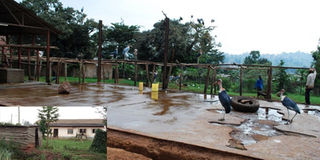Masaka secures Shs1b to construct modern abattoir

Slaughter zone. Marabou storks search for what to eat at Masaka Municipal abattoir in Kirumba Village. The facility is in a sorry state. (Inset) One of the pits that was dug to hold water coming from the slaughter house. PHOTO BY GERTRUDE MUTYABA
What you need to know:
- The abattoir, which sits on a one-acre piece of land, serves Masaka District and parts of Kalungu, Kyotera and Lwengo districts.
- Mr George William Kivumbi, the chairperson of Kirumba Katwe Village, said when cows die, the carcasses are thrown in the open which causes a bad smell.
Masaka Municipality has secured more than Shs1b for the construction of a new abattoir in Kirumba Village, Katwe-Butego Division, Masaka Municipality.
The existing structure is operating under filthy conditions, exposing meat consumers to diseases related to poor hygiene.
Mr Emmanuel Gakyalo, the Masaka Municipality deputy town clerk, said the work for the new abattoir will commence next financial year.
The project is part of Uganda Support to Municipal Infrastructure Development (USMID) programme funded by the World Bank.
“We are now very sure the construction of the modern abattoir will start in July. The new facility will have, among others, deep freezers and refrigerators where meat will be kept safely,” Mr Gakyalo said on Wednesday.
The plan to construct a new abattoir comes after residents tasked authorities to close the facility for operating under filthy conditions.
Mr Godfrey Kayemba, the Masaka Municipality Mayor, said as they prepare to put up a modern abattoir, a municipal tractor will be sent regularly to take away waste of slaughtered animals.
“After constructing a modern abattoir, blood and cow dung will be of more use because we are planning to put modern equipment for collecting them for sale,” he said.
Mr Dennis Lukanga Majwala, the chairperson of Katwe-Butego Division, where the abattoir is located, condemned municipal council authorities for failing to attend to residents’ concerns.
“Uncollected animal wastes should have been removed ‘yesterday’, people’s lives are in danger. If the sanitation cannot be improved now, the best thing should be to close the abattoir as we wait for the new facility,” he said.
Mr George William Kivumbi, the chairperson of Kirumba Katwe Village, said when cows die, the carcasses are thrown in the open which causes a bad smell.
“There is no proper disposal of animal wastes generated from the abattoir, even the unwanted horns and skins are thrown in the compound of residents which put their lives in danger,” he said.
When one visits the place, the stench from uncollected dung and pool of blood that cover the potholed slaughter house floor is bad.
Outside the slaughter house lies an uncovered small channel where water flows to the two open lagoons.
Close to the lagoons, in a distance of almost 30 metres, are two dilapidated pit-latrines. During the rainy season, water mixes with animal wastes and runs through people’s houses.
Some members on the abattoir management committee, however, attributed the bad smell to many piggery farms around the area.
Capacity
The abattoir, which sits on a one-acre piece of land, serves Masaka District and parts of Kalungu, Kyotera and Lwengo districts.
On average, 13 cows are slaughtered on daily basis. Much of the meat is sold in butcheries around Masaka Town and the neighbouring districts.
However, during festive seasons such as Christmas and Idd, the number of animals slaughtered rises to 200.




